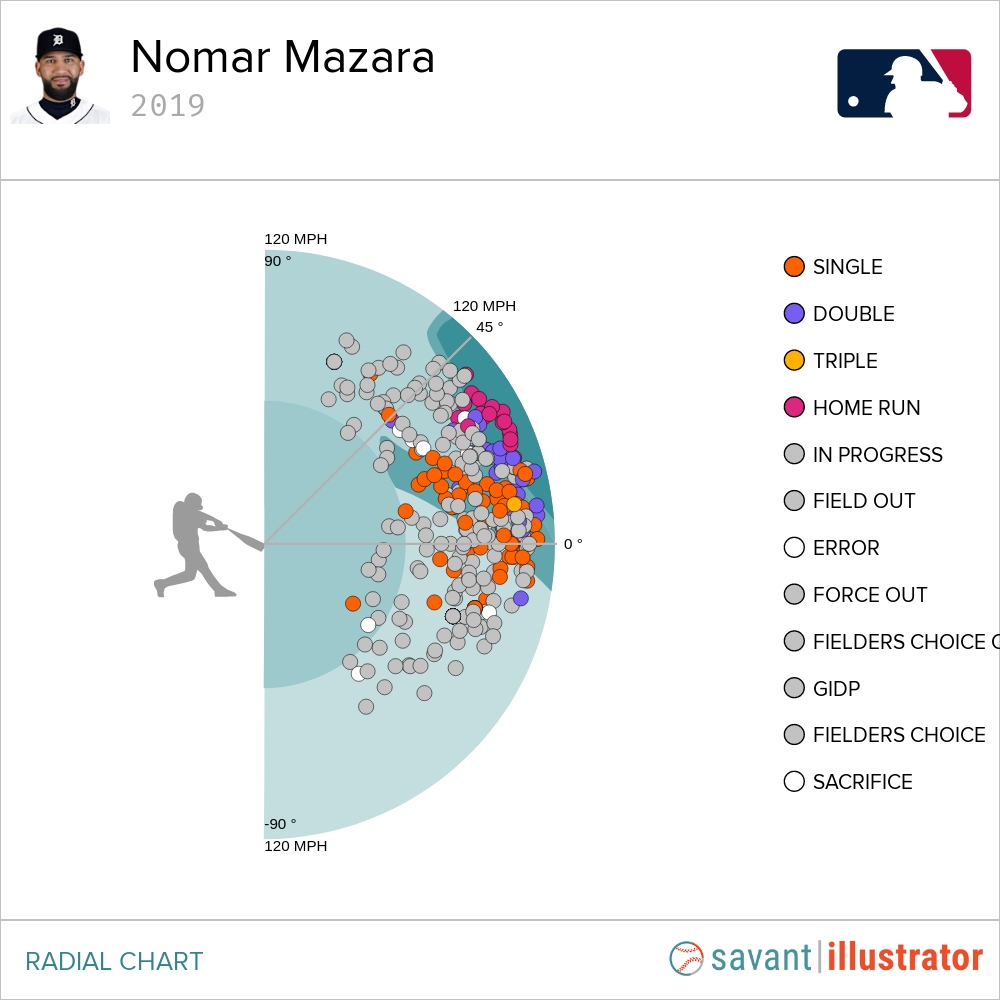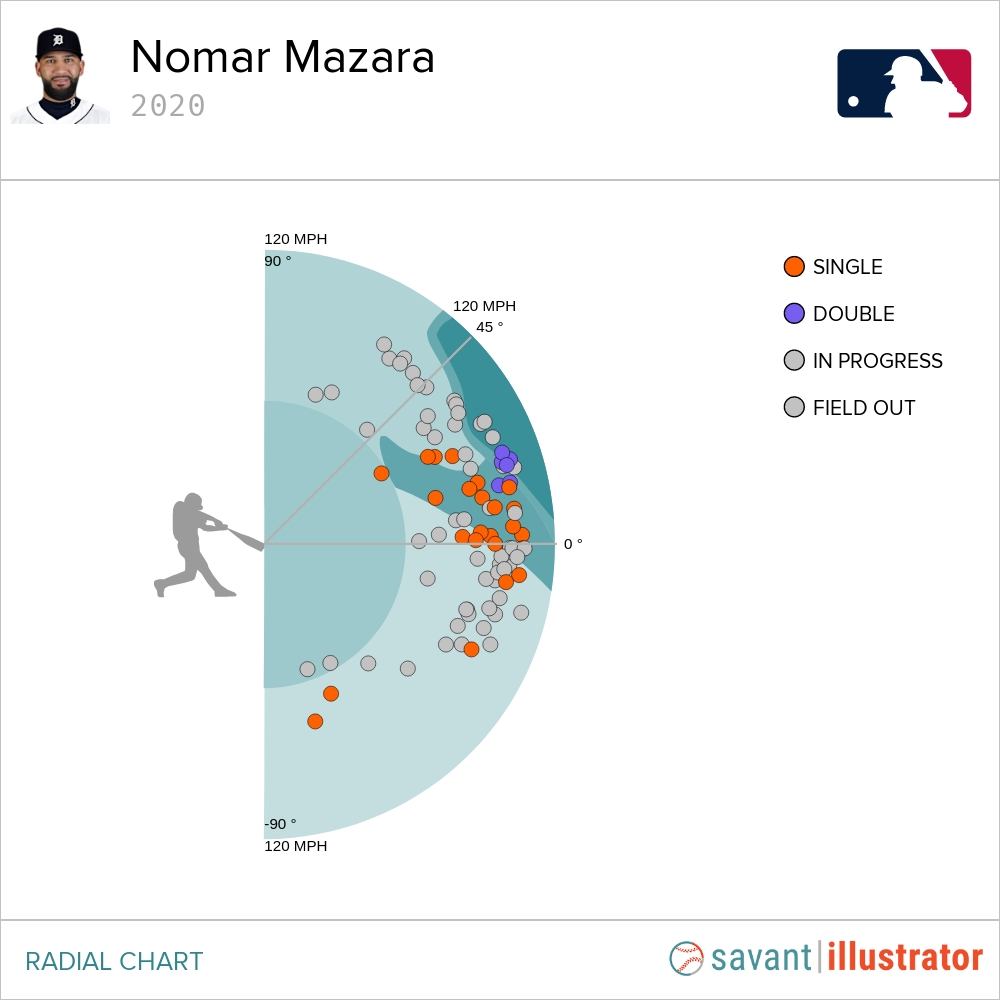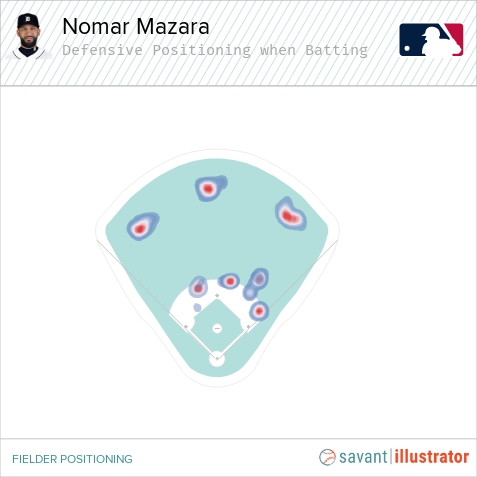There’s no question that 2020 was a season that Nomar Mazara would like to forget. After hitting 20 home runs in his first three MLB seasons from 2016-2018, and 19 home runs in 116 games in 2019 in his final season in Texas, many experts felt that at only 25-years-old, Mazara would thrive on the South Side of Chicago, especially among a star-studded lineup that also included Eloy Jimenez, Luis Robert, Yasmani Grandal, and Jose Abreu, just to name a few. While Mazara certainly brought his share of flaws to the White Sox organization, it was expected that his power would at least help boost a White Sox team that was looking to take the next step in the AL Central.
Chicago’s baseball team on the South Side did make some gains in the Central, as they made the playoffs as a Wild Card, their first postseason appearance since 2008. Unfortunately, Mazara had little impact on the club’s turnaround, as he nosedived and had the worst season of his MLB career thus far. In 42 games and 149 plate appearances, Mazara posted a 67 wRC+, .267 wOBA, and 0.2 WAR, all career worsts. Furthermore, his power, his main calling card in Texas, regressed sharply last year, as he not only hit just one home run but also posted a .066 ISO, a nearly 134 point drop from his 2019 ISO.
Thus, it came as no surprise that the White Sox non-tendered the Dominican-born outfielder this Winter, which eventually cleared the way for their acquisition of Adam Eaton this off-season. From 2016-2019, all of Mazara’s value came from the offensive end, and after such a porous campaign at the plate, there really was no reason for the White Sox to hold onto him, especially with glaring defensive issues that they had to fix in the off-season (though who knows if Eaton will solve that issue).
After getting little interest this off-season, the Detroit Tigers decided to take a flier on Mazara, as they inked him to a one-year, $1.75 million in February. According to Roster Resource, Mazara is slated to be the Tigers’ starting right fielder, and he could be a nice fill-in as the Tigers continue their rebuilding process. That being said, will Mazara offer the Tigers anything on the offensive end? Furthermore, could he rebound in his new home field at Comerica Park and make him enticing to fantasy owners looking for cheap or extreme late-round value in the outfield?
Unfortunately for both the Tigers and fantasy owners, Mazara’s profile is a difficult one to decipher.
“Empty” Hard Hit Contact?
What makes Mazara so interesting as a possible outfield option is his ability to hit the ball hard over the course of his career. Since debuting in 2016, Mazara has posted an average career hard-hit rate of 39.1 percent, according to Baseball Savant. Even during his rough 2020, he was able to hit the ball with serious contact, as he posted a 48.9 percent hard-hit rate, according to Savant. Furthermore, Mazara’s ability to hit the ball hard was further reiterated by his exit velocity on batted balls last year, as he posted a 91 MPH exit velocity with the White Sox in 2020, which was a career-high.
On a percentile end, Mazara’s exit velocity ranked in the 82nd percentile and his hard-hit rate in the 90th percentile in 2020. Thus, on a pure power end, not many hitters rank up there with Mazara.
And yet, despite the promise of his tantalizing power tool, the rest of Mazara’s metrics just underwhelm. After posting a barrel rate of 10.7 percent in 2019, Mazara saw his barrel rate regress by 3.1 percentage points in 2020. Furthermore, Mazara ranked in the 15th percentile in xwOBA and K percentage, 18th percentile in xBA (expected batting average), and 37th percentile whiff rate, all concerning rankings.
Lastly, Mazara only posted an average launch angle of 6.7 last year, a substantial decrease from his 10.4 average launch angle in 2019 with the Rangers. In fact, to visualize the difference in launch angle from 2019 to 2020, let’s take a look at his radial charts from each season.
Here’s his 2019 radial chart from his last year with the Rangers:

As one can see, there are a lot of groundballs, and that was further proved by his 47.1 percent groundball rate in 2019. However, when Mazara was able to launch the ball a bit, satisfactory results tended to follow, as evidenced by the light purple (or fuchsia?) dots on the chart. Additionally, Mazara was also able to produce moonshots like this one below when he was able to get under the ball and utilize his natural power:
https://gfycat.com/scaredgloomyarcticfox
However, Mazara wasn’t able to transition the launch angle from 2019 to a shorter, COVID-affected season. And thus, the rest of his hitting suffered, as evidenced by his 2020 radial chart below in his lone season in Chicago:

The amount of groundballs displayed in this chart is concerning, especially for a hitter with such raw power as Mazara. And it’s not just the groundball outs that are concerning, but also the lack of diversity in the kind of hits he had in 2020. As one can see from his radial chart, a lot of Mazara’s base hits were singles, and that’s just not enough for a hitter who relies on power and strikes out as often as Mazara.
Thus, the big question for Mazara in 2021 in Detroit will be if he can find that launch angle that he had in Texas in 2019, or maybe something better. Mazara cannot survive being a sub-seven and plus-50 percent groundball rate hitter again, even if he will only be 26-years-old in 2021. However, if he is able to find more launch on his batted balls next season, it is possible that Mazara could experience some surprising success at the plate with the Tigers.
Mazara, Offspeed Pitches, and the Shift
So, Mazara has struggled to put the ball in the air, and last year, that struggle was amplified in a shortened 60-game season. However, what changes metrically in 2020 may have contributed to his lower production, more-groundball heavy batted ball approach last season?
Well, looking at his production against offspeed pitches last year paints a telling tale.
| Year | Pitch Type | % | WOBA | XWOBA | EV | LA | Whiff% | PutAway% |
|---|---|---|---|---|---|---|---|---|
| 2020 | Offspeed | 13 | 0.199 | 0.305 | 85.8 | -5 | 14.7 | 14.3 |
| 2019 | Offspeed | 12 | 0.466 | 0.426 | 93.4 | 5 | 22.7 | 9.1 |
| 2018 | Offspeed | 13.6 | 0.323 | 0.349 | 89.3 | -2 | 27.9 | 6.7 |
| 2017 | Offspeed | 15.8 | 0.289 | 0.328 | 88.4 | 5 | 32.5 | 17.1 |
As the table demonstrates, Mazara pretty much saw the same percentage of offspeed pitches last year as he did any other season. However, after showing gains in 2018 and 2019, he dipped dramatically in his effectiveness against the pitch, as his exit velocity, launch angle, wOBA, and xwOBA all took dramatic dives. Furthermore, he also saw an increase in put-away percentage, though to be fair that percentage had gone up from 2018 to 2019 as well, so that data may be less relevant.
What is interesting though is that Mazara had a relatively low whiff rate on offspeed pitches last year, for, at 14.7 percent, it was his lowest whiff rate against the pitch over the past four years. Furthermore, the 206 point difference in wOBA and xwOBA, also suggests that Mazara just wasn’t finding the holes in 2020 in comparison to years past on batted balls against offspeed pitches.
However, as I dug deeper into Mazara’s profile, one thing did stick out: teams shifted more against him in 2020, and unfortunately, it seemed like that had an effect on his ability to garner hits, especially up the middle. Over his career, Mazara has demonstrated a more opposite-field and up-the-middle hitting approach, which is pretty atypical for a power hitter. Last year, according to his batted ball metrics, he hit the ball up the middle 33.7 percent of the time and to the opposite field 35.9 percent of the time. These numbers deviate a little from his career batted ball metrics, for, over his career, he has hit the ball up the middle 40 percent of the time.
A big reason Mazara maybe has tried to hit the ball more to the opposite field is due to how teams have been playing him shift-wise, as evidenced by the shift chart below:

It’s an interesting shift because defenses last year basically are taking away his ability to hit offspeed pitches up the middle for hits. It’s not necessarily a true pull shift either, because notice how the outfield plays pretty normally in comparison to their infield counterparts. That being said, the scouting on Mazara in regard to playing him on defense seemed pretty apt when one takes a look at his spray chart on offspeed pitches from 2020:

Furthermore, in addition to defenses employing this kind of shift, they also employed it more frequently, as defenses employed a shift 55 percent of the time against him last year, in comparison to 41.8 percent of the time in 2019.
And it made a difference.
Here is Mazara in 2019 getting a hit up the middle on an offspeed pitch against the Seattle Mariners, who opted not to employ a defensive shift.
https://gfycat.com/preciouslivegallinule
Now, let’s flash forward a year later in Chicago, and see how the Twins decide to employ a shift this time around to Mazara and what kind of results it produces.
https://gfycat.com/rapidcarefulfairyfly
Instead of being a base hit up the middle, it is just an easy groundout for the Twins defense, thanks to the shift. What’s ironic about the difference between the two at-bats is that Mazara hit the ball HARDER in the 2020 at-bat in comparison to the 2019 at-bat. Overall, Mazara only posted a .280 wOBA against the shift, a big regression from his .343 wOBA against the shift a season ago.
Thus, now that teams may know how to play him in 2021, Mazara may need to make adjustments, especially in regard to his swing approach on offspeed pitches, if he wants to be able to boost his numbers back up and be a semi-productive hitter again next season and beyond.
How Mazara Compares in the AL Central
According to Fantasy Pros, Mazara’s ADP is 472, which pretty much is waiver wire territory in most leagues. Furthermore, in Scott Chu’s rankings of Top 100 outfielders, Mazara came in exactly at 100, which was behind players like Oscar Mercado and Kevin Pillar, but ahead of ones like Jason Heyward and Kevin Kiermeier.
Thus, I wanted to see how Mazara compared in the American League Central to other starting corner outfielders who are expected to have an impact on their respective clubs.
In the table below, I compare Mazara to other “impact” AL Central corner outfielders in regard to strikeout and walk data, as well as wRC+ and wOBA metrics from 2018 to 2020. I also did include recent Tigers free agent signing Robbie Grossman to the mix, as it does give some context in terms of how Mazara compares to another outfielder who is expected to contribute on the Tigers roster.
| Name | PA | BB% | K% | BB/K | ISO | BABIP | wOBA | wRC+ |
|---|---|---|---|---|---|---|---|---|
| Andrew Benintendi | 1328 | 10.6% | 19.8% | 0.54 | 0.165 | 0.327 | 0.340 | 109 |
| Adam Eaton | 1202 | 9.6% | 16.8% | 0.57 | 0.138 | 0.324 | 0.339 | 108 |
| Max Kepler | 1403 | 10.9% | 16.5% | 0.66 | 0.223 | 0.240 | 0.334 | 109 |
| Eddie Rosario | 1413 | 5.0% | 15.9% | 0.32 | 0.210 | 0.287 | 0.334 | 109 |
| Robbie Grossman | 1139 | 12.3% | 18.2% | 0.68 | 0.131 | 0.301 | 0.322 | 104 |
| Nomar Mazara | 1154 | 6.8% | 23.2% | 0.29 | 0.173 | 0.307 | 0.318 | 91 |
Unfortunately for fantasy owners thinking of taking a flier on Mazara, the early returns are not necessarily good, especially when compared to other Central corner outfielder candidates. Mazara ranks last of the sample group above in terms of wRC+ by nearly 13 points, and he also ranks last in both strikeout rate (23.2 percent) as well as BB/K ratio (0.29). Furthermore, the fact that he ranked around the middle in terms of BABIP doesn’t necessarily show that his struggles were due to bad luck either.
Of the bunch, I figured Eddie Rosario compared most closely to Mazara. Not only did Rosario’s BB/K rate over the past three seasons mirror Mazara’s (0.32 to 0.29), but Rosario also sported a lower walk rate as well, as it was nearly two percentage points less than Mazara’s walk rate. Thus, I took a deeper look into their Statcast data, and saw how the two compared:
| Name | PA | EV | maxEV | LA | Barrel% | HardHit% |
|---|---|---|---|---|---|---|
| Nomar Mazara | 1154 | 90 | 117.1 | 7.7 | 8.6% | 42.0% |
| Eddie Rosario | 1413 | 88.3 | 108.6 | 17.4 | 7.2% | 34.6% |
Surprisingly, the projected Tigers right fielder compares pretty favorably to Rosario, as he outdoes the new Cleveland outfielder in every category except launch angle. According to Fantasy Pros, Rosario has an ADP of 109 and is owned in 89 percent of Yahoo! leagues and 98 percent of ESPN leagues. This is a far cry from Mazara’s fantasy ownership, as Mazara is only owned in two percent of Yahoo! leagues and one percent of ESPN leagues.
Despite that massive difference, I am not sure Rosario is that much better than Mazara, especially when it comes to chasing outfield help. Yes, Rosario is a little more proven than Mazara, but his plate discipline is just as bad as Mazara’s, and he’ll be leaving the “La Bomba” squad, which could also suppress some of his numbers, especially since he’ll have less help around him in the Cleveland lineup.
Now, does that mean one should draft Mazara before Rosario? Probably not. However, fantasy owners interested in Rosario could wait and maybe snag Mazara either at a super low price in auctions or in the late rounds of a deep league and perhaps get similar value at a fraction of what it would cost for Rosario.
Mazara’s Outlook for 2021
The big issue for Mazara will be playing time, as he pretty much has been a platoon player so far in his MLB career. He only has 600 career plate appearances against left-handed pitchers in comparison to 1,738 plate appearances against right-handed pitchers, and last year, only 26 of his 149 total plate appearances came against left-handed pitchers. The Tigers are obviously not as deep offensively as the White Sox a year ago, but Mazara could be thrust into another platoon in Detroit, as Mazara and Grossman’s acquisitions push Victor Reyes, who’s been a starter the past couple of years in Detroit, out of a regular role. According to Roster Resource depth charts, it is projected that Reyes and Mazara could platoon in right field in 2021.
If Mazara does platoon, this will undoubtedly hurt his value, which is a shame because his skill set does offer some tantalizing potential. Mark McElroy of Pitcher List wrote a post last year on Mazara, and he too warned of the “platoon” effect damaging Mazara’s profile, and this segment that he wrote in regard to Mazara’s outlook in 2020 still seems relevant for 2021:
“The fear, of course, is that Mazara is foisted into a platoon. While it would be an indication that he isn’t responding at the plate, it doesn’t mean a fantasy funeral. While we need players to play and accumulate stats, fantasy owners might be better off if they didn’t get his 2019 results against LHPs. In daily leagues, streaming is still a viable option and one that comes at a discount.”
“New Team, New Nomar Mazara?” by Mark McElroy; Pitcher List
The good news for the Tigers is that they are rebuilding, and they will need offensive production after not getting much of it last season, as they ranked 25th in wRC+ as a team, according to Fangraphs. Furthermore, they have a new manager in A.J. Hinch, who tends to be more analytics-friendly than the Tigers’ previous manager Ron Gardenhire, as well as Mazara’s manager last season, Rick Renteria. Thus, if Mazara hits, he’ll get at-bats under Hinch, regardless of who is pitching.
That being said, Mazara may not have a long leash, and he has to have a good start if he wants to justify playing time in Detroit over the course of a full 162-game season. That being said, if Mazara avoids the injury list to begin the season (unlike last year) and gets off to a hot start, he could produce some surprising value and produce Rosario-like production on a bargain.
He will have to see some gains in his launch angle, but he did post a 10.7 launch angle in 2019 and an 11.7 one in 2017, so it is possible that Mazara could get more loft under the ball in 20201 with the help of the new Tigers coaching staff, and put his bad 2020 behind him.
Of course, if that launch angle doesn’t improve, and he continues to hit the ball on the ground, Mazara may not have long in Detroit…
Or perhaps at the MLB level in general beyond next season.

